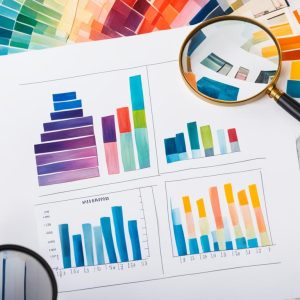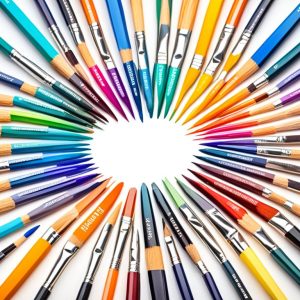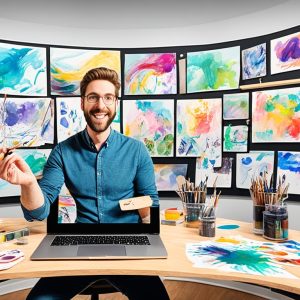Digital art is an exciting and rapidly growing field that combines technology and artistic expression. As a digital artist, mastering key techniques and concepts is crucial to elevating your work and standing out in a competitive market.
In this article, I’m going to share some valuable tips from professionals in the industry that will help you refine your skills and take your digital art to the next level. Whether you’re a beginner or an experienced artist, these tips will provide you with insights and inspiration to enhance your digital art techniques.
Key Takeaways:
- Experiment with different brushes and techniques to expand your artistic repertoire.
- Regularly practice digital sketching to improve your accuracy and speed.
- Master color theory and composition to create visually captivating artwork.
- Develop your unique artistic style by finding inspiration and experimenting with different techniques.
- Continuously expand your skill set through workshops, online courses, and seeking feedback from other artists.
Understanding the Basics of Digital Art
As an artist, diving into the world of digital art opens up a realm of creative possibilities. By harnessing the power of digital tools, such as computers or tablets, you can explore a wide range of artistic styles and techniques. Let’s take a closer look at the basics of digital art, including the essential tools and software that will help you bring your artistic vision to life.
Digital art, in its simplest form, is a medium of artistic expression that relies on digital tools and technologies. It encompasses various art forms, including painting, drawing, and composition. Digital artists leverage the capabilities of computers or tablets to create stunning visuals, taking advantage of advanced features and functionalities that traditional art mediums may not offer.
When it comes to digital art, having the right tools and software is essential. These tools enable artists to manipulate digital canvases, experiment with different brushes and textures, and bring their artistic visions to fruition. Some popular digital art tools include graphic tablets, styluses, and touchscreens. These devices allow for precise control and mimic the tactile experience of traditional art-making.
Moreover, digital art software provides a platform for artists to create, edit, and refine their artwork. There is a wide range of digital art software available, each offering unique features and capabilities. Some popular choices among digital artists include Adobe Photoshop, Corel Painter, and Procreate. These software programs provide a plethora of tools and effects, empowering artists to explore their creativity.
One of the advantages of digital art is its flexibility and versatility. Unlike traditional mediums, digital art allows for effortless editing, layering, and experimentation. Artists can easily modify their artwork, undo mistakes, and try various techniques without fear of damaging the original. This adaptability empowers artists to push their boundaries and explore new artistic horizons.
“Digital art provides endless possibilities for artistic exploration and innovation, making it an exciting and dynamic field to be a part of.” – John Adams, Digital Artist
Whether you are a seasoned traditional artist transitioning into the digital realm or a beginner eager to embark on your artistic journey, understanding the basics of digital art is key. By familiarizing yourself with the tools and software available, you can tap into the vast potential of digital art and unlock your creativity. So, let’s dive in together and start creating captivating digital masterpieces!
Tips for Digital Sketching
Digital sketching is an essential skill for digital artists, allowing me to create quick, efficient, and editable sketches. By incorporating these tips into my digital art practice, I can improve my sketching skills and lay the foundation for more complex digital artwork.
Use References to Improve Accuracy
When digitally sketching, using references can greatly enhance the accuracy and realism of my artwork. Whether it’s a photograph, a still life, or a digital art reference, studying and analyzing the subject matter helps me understand its proportions, lighting, and textures. By referring to these visual aids, I can ensure that my sketches accurately represent the intended subject.
Experiment with Different Brushes and Techniques
One of the advantages of digital sketching is the vast array of brushes and techniques available. By exploring various brush settings, textures, and strokes offered by digital art software, I can achieve different effects and styles in my sketches. From creating fine lines to bold strokes, experimenting with brushes allows me to add depth and character to my digital sketches.
Practice Regularly
As with any artistic skill, practice is crucial for improving digital sketching abilities. Setting aside time to regularly sketch, even for short periods, helps me refine my hand-eye coordination, speed, and accuracy. By consistently practicing digital sketching, I can develop a confident and fluid sketching technique that translates into more polished and refined artwork.
To further enhance your digital sketching skills, check out the wide range of online resources and tutorials available. They provide valuable insights into sketching techniques, offer step-by-step demonstrations, and provide inspiration for exploring new artistic styles. Remember, the key to improving digital sketching is a combination of using references, experimenting with different brushes and techniques, and practicing regularly.
Mastering Color Theory and Composition
Color theory and composition are vital elements of digital art that have a profound impact on the visual appeal of an artwork. As a digital artist, understanding the principles of color harmonies and composition techniques is key to creating captivating and harmonious artwork that effectively communicates your intended message.
1. Understanding Color Harmonies
Color harmonies refer to the combinations of colors that work well together and create a visually pleasing effect. By studying color theory, you can learn about complementary colors, analogous colors, and other color schemes that can enhance the overall aesthetic of your digital artwork. Experimenting with different color harmonies will allow you to evoke specific emotions and create a sense of balance in your compositions.
2. Experimenting with Palettes
When it comes to digital art, the color palette you choose can greatly influence the mood and atmosphere of your artwork. Try experimenting with different palettes to see how they affect the overall look and feel of your compositions. Whether you prefer vibrant and bold colors or a more subdued and monochromatic palette, exploring various options will help you find the perfect combination for your artistic vision.

3. Learning Composition Techniques
Composition plays a crucial role in guiding the viewer’s eye and creating visual interest in your artwork. By mastering composition techniques, such as the rule of thirds, leading lines, and focal points, you can effectively structure your artwork and convey your intended message. Experiment with different compositions to create dynamic and engaging digital artworks that captivate your audience.
“Color and composition are powerful tools that can transform a simple digital artwork into a captivating masterpiece.”
By implementing these tips into your digital art practice, you can elevate your skills in color theory and composition, resulting in visually stunning and impactful artwork. Mastering these elements will allow you to effectively communicate your artistic vision and create digital art that resonates with your audience.
Developing Your Unique Style
Developing a unique style is essential for digital artists to distinguish themselves in a saturated market. It is through our style that we express our personal artistic identity and bring our artistic vision to life. To cultivate a distinctive digital art style, there are a few key steps I recommend taking.
Experiment with Different Techniques
One of the best ways to develop your digital art style is to experiment with different techniques. By exploring various brush strokes, textures, and effects, you can discover new ways to express your artistic vision. Don’t be afraid to step outside of your comfort zone and try something different – you might just stumble upon a technique that becomes a signature element of your style.
Seek Inspiration from Other Artists
Studying the works of other artists can be a great source of inspiration and guidance in developing your own style. Analyze their use of color, composition, and subject matter to gain insights into different artistic approaches. While it’s important to find your own unique voice, drawing inspiration from others can help you refine your technique and develop a deeper understanding of the digital art world.
“Every artist steals and every artist reinvents what they steal into something completely new.”
Find Your Artistic Voice
Artistic expression is deeply personal, and finding your artistic voice is a journey of self-discovery. Reflect on your passions, interests, and experiences to uncover what drives you as an artist. What themes or emotions resonate with you the most? What message do you want to convey through your art? By aligning your personal artistic expression with your digital artwork, you’ll be able to create authentic and meaningful pieces that reflect your unique artistic identity.

Remember, developing a unique style takes time and practice. Embrace the process, allow yourself to evolve artistically, and don’t be afraid to make mistakes. Your journey towards developing your own digital art style is just as important as the destination – enjoy every step of the way!
Expanding Your Skill Set
To truly excel in the field of digital art, it’s crucial to continuously expand your skill set and stay up to date with the latest trends and techniques. By actively seeking opportunities for learning and growth, you can elevate your digital art skills and take your artwork to new heights.
Online Courses and Workshops
One effective way to expand your skill set is by enrolling in online courses and attending digital art workshops. These platforms offer a wide range of courses taught by industry professionals who share their expertise and insights. Whether you’re interested in learning advanced digital art techniques or honing your skills in a specific area, online courses and workshops provide valuable learning experiences.
Additionally, participating in digital art workshops allows you to connect with fellow artists, share ideas, and gain inspiration from different perspectives. Collaborating with like-minded individuals can foster growth and encourage exploration of new artistic styles and concepts.
Art Events and Exhibitions
Attending art events and exhibitions is another fantastic way to expand your skill set. These events provide opportunities to explore various art forms, interact with established artists, and gain exposure to innovative techniques and styles. By immersing yourself in the art community, you can network, exchange ideas, and discover new avenues for artistic expression.
Feedback and Critique
Seeking feedback and critique from other artists is a valuable learning tool. Constructive criticism helps identify areas for improvement and provides fresh perspectives on your artwork. Engaging with artists who have different perspectives and experiences can inspire you to explore new creative paths and refine your techniques. Embrace this process as an opportunity for growth and development.
Remember, learning is a continuous journey. By taking advantage of online courses and workshops, attending art events, seeking feedback, and engaging with the art community, you can master advanced digital art techniques, broaden your creative horizons, and stay at the forefront of this rapidly evolving field.
“Continuous learning is the key to becoming a proficient digital artist. Embrace new opportunities, seek feedback, and never stop exploring. Expand your skill set, and watch your artwork soar.” – Lynn Davis, Digital Artist
Mastering Digital Art Tools and Software
Digital art tools and software are essential for creating stunning digital artwork. As a digital artist, it is crucial to familiarize yourself with a variety of tools, software programs, and equipment available in the market. By mastering the use of these digital art tools and software, you can significantly enhance your workflow, optimize your creative process, and produce high-quality digital art.
There are numerous digital art software options available, each offering unique features and capabilities. Popular software programs like Adobe Photoshop, Corel Painter, and Procreate provide a wide range of tools and functionalities tailored specifically for digital artists. These software programs allow you to edit and manipulate your artwork, create custom brushes, apply special effects, and much more.
In addition to digital art software, having the right digital art tools and equipment is essential for a seamless creative process. A graphics tablet or a pen display is a must-have for precise and accurate input while creating digital art. These devices are designed to mimic traditional drawing and painting techniques, providing artists with a natural and intuitive digital art experience.
“Digital art tools and software have revolutionized the way artists create and experiment with art. The possibilities are endless when you have the right tools at your disposal.” – John Smith, Digital Artist
Furthermore, it’s important to consider other digital art equipment that can enhance your overall digital art experience. An adjustable monitor or a color-calibrated display ensures accurate color representation, allowing you to create vibrant and true-to-life digital artwork. Additionally, investing in a reliable computer with sufficient processing power and memory will enable you to work seamlessly with complex digital art projects.
Mastering digital art tools and software requires practice, experimentation, and continuous learning. Take advantage of online tutorials, workshops, and communities to expand your knowledge and skills. Stay up to date with the latest updates and features offered by your chosen software programs to maximize your creative potential. By harnessing the power of digital art tools and software, you can unlock new possibilities and unleash your artistic vision.
Conclusion
Becoming a better digital artist requires practice, dedication, and a commitment to continuous improvement. By implementing the expert tips discussed in this article, you can elevate your work to new heights and create captivating digital masterpieces.
Start by understanding the basics of digital art, including the tools and software available to you. This knowledge will provide a solid foundation for your artistic journey and help you make the most of your digital art experience.
Mastering color theory and composition is another essential step toward improvement. By understanding how colors work together and experimenting with different compositions, you can create visually appealing and harmonious artwork that grabs the viewer’s attention.
Developing your own unique style is crucial in standing out as a digital artist. Take inspiration from other artists, experiment with different techniques, and find your own artistic voice. This will not only set you apart but also add depth and authenticity to your digital creations.
Remember to continuously expand your skill set. Take advantage of online courses, workshops, and art events to learn new techniques and stay on top of the latest trends in digital art. Embrace opportunities for feedback and critique from fellow artists to refine your skills and grow as an artist.
Finally, mastering digital art tools and software is essential for optimizing your workflow and producing high-quality digital art. Familiarize yourself with the various tools and software programs available, and practice using them to enhance your creative process.
With these tips in mind, continue to explore, experiment, and refine your skills as a digital artist. There is always room for improvement, so embrace the journey and unleash your creativity to become the best digital artist you can be!
FAQ
What is digital art?
What are some key tips for digital sketching?
Why is color theory and composition important in digital art?
How can I develop my own unique style in digital art?
How can I expand my skill set in digital art?
What are some essential digital art tools and software?
How can I become a better digital artist?
Share this content:






